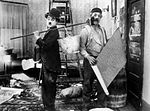 | Commedia dell'arte (/kɒˈmeɪdiə dɛlˈɑːrteɪ, kə-, -ˈmɛdiə, -ˈɑːrtiː/ kom-AY-dee-ə del-AR-tay, kəm-, -ED-ee-ə, -AR-tee, Italian: [komˈmɛːdja delˈlarte];... 50 KB (5,737 words) - 23:58, 9 April 2024 |
 | Pantalone (redirect from Pantaloon (commedia dell'arte)) characters found in commedia dell'arte. With his exceptional greed and status at the top of the social order, Pantalone is "money" in the commedia world. His full... 12 KB (1,650 words) - 22:08, 18 January 2024 |
 | Columbina (redirect from Columbine (the commedia dell'arte)) dove"; French and English: Colombine) is a stock character in the commedia dell'arte. She is Harlequin's mistress, a comic servant playing the tricky slave... 8 KB (942 words) - 20:35, 18 January 2024 |
Commedia dell'arte masks are a type of mask worn by performers of commedia dell'arte. Masks are an integral part of the performance, and each character... 9 KB (1,201 words) - 13:02, 24 April 2024 |
 | Innamorati (redirect from Innamorata (commedia dell'arte)) 'lovers') were stock characters within the theatre style known as commedia dell'arte, who appeared in 16th-century Italy. In the plays, everything revolved... 13 KB (1,342 words) - 22:54, 10 March 2024 |
 | Lélio is a stock character of the commedia dell'arte. Lélio represents the happy innamorati, loved by the woman he loves (often Isabella), always friendly... 1 KB (135 words) - 21:31, 25 April 2024 |
Giandoja, Piedmontese: [dʒaŋˈdʊja]) is one of the masks of the Italian commedia dell'arte, typically representing the town of Turin (and Piedmont in general)... 3 KB (337 words) - 16:14, 16 March 2024 |
 | Harlequin (category Commedia dell'arte male characters) best-known of the comic servant characters (Zanni) from the Italian commedia dell'arte, associated with the city of Bergamo. The role is traditionally believed... 25 KB (2,994 words) - 14:25, 24 March 2024 |
Il Dottore (category Commedia dell'arte characters) (Italian: [balanˈtsoːne]; Bolognese Emilian: Dutåur Balanzån), is a commedia dell'arte stock character, in one scenario being an obstacle to young lovers... 9 KB (983 words) - 20:14, 26 March 2024 |
 | Zanni (category Commedia dell'arte characters) Zanni (Italian: [ˈdzanni]), Zani or Zane is a character type of commedia dell'arte best known as an astute servant and a trickster. The Zanni comes from... 17 KB (2,483 words) - 22:13, 18 January 2024 |
 | era of classical theatre. It developed partly from the 16th century commedia dell'arte tradition of Italy and other European and British stage traditions... 55 KB (6,127 words) - 17:37, 9 April 2024 |
 | plays. The Punch and Judy show has roots in the 16th-century Italian commedia dell'arte. The figure of Punch derives from the Neapolitan stock character of... 36 KB (4,226 words) - 02:51, 1 May 2024 |
 | Theatre of Italy (section Commedia dell'arte) in the vernacular. The Commedia dell'arte (17th century) was, at first, an exclusively Italian phenomenon. Commedia dell'arte spread throughout Europe... 67 KB (8,549 words) - 22:03, 25 April 2024 |
 | Pierrot (category Commedia dell'arte male characters) PEE-ə-ROH; French: [pjɛʁo] ) is a stock character of pantomime and commedia dell'arte, whose origins are in the late seventeenth-century Italian troupe... 75 KB (8,975 words) - 06:54, 17 March 2024 |
sometimes called the Commedia Commedia dell'arte, a professional form of theatre that began in Italy in the mid-16th century La Commedia, an early theatre in Naples... 553 bytes (98 words) - 06:57, 24 April 2024 |
 | him polish his comedic abilities while he began writing, combining Commedia dell'arte elements with the more refined French comedy. Through the patronage... 45 KB (5,910 words) - 16:04, 26 April 2024 |
 | forms in the West between the 15th and 19th centuries, including commedia dell'arte from Italian theatre, and melodrama. The general trend was away from... 86 KB (10,141 words) - 10:29, 29 April 2024 |
Lazzi (category Commedia dell'arte) or witticism) are stock comedic routines that are associated with commedia dell'arte. Performers, especially those playing the masked Arlecchino, had many... 11 KB (1,433 words) - 15:16, 13 January 2024 |












